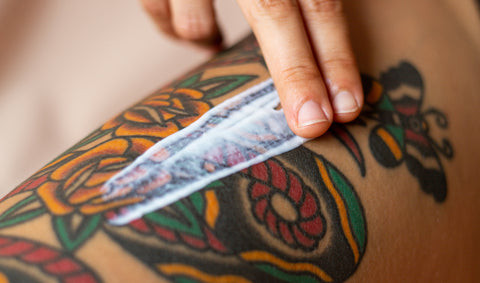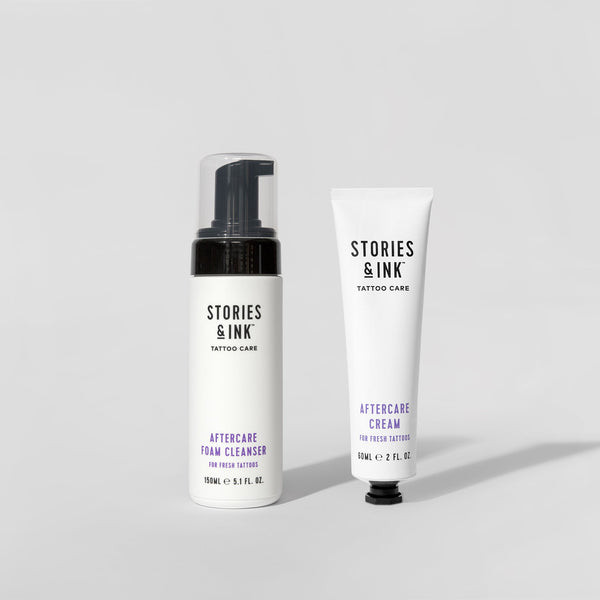Getting a new tattoo is an exciting experience, but understanding the healing process is crucial for ensuring your ink looks its best and avoids complications. One common question for those new to tattoos, or even seasoned collectors, is: “How long will my tattoo take to heal?” It’s normal to see scabbing as part of this process, and while it can be concerning if you’re unprepared, it’s usually a sign that your body is doing its job. Let’s break down what to expect during tattoo healing, focusing on the scabbing phase and how long it typically lasts.
Understanding Tattoo Scabbing: Why It Happens
To understand tattoo healing and scabbing, it’s essential to recognize that getting a tattoo essentially creates a wound on your skin. As Barbara Crane, content manager at Stories & Ink and a tattoo enthusiast, explains, “To me it just seemed normal as it’s technically a wound that needs to heal, so scabs made perfect sense.”
 Woman with tattoos smiling
Woman with tattoos smiling
Image: Barbara Crane, sharing her experience with tattoo healing.
Scabs form as a protective layer over this wound, shielding it from bacteria and debris while your skin works to repair itself. When you get a tattoo, the needles create tiny punctures in your skin, and your body’s natural defense mechanisms kick in. White blood cells rush to the area to fight off potential infection and initiate the healing process.
Several factors can make tattoo scabbing more pronounced. Improper aftercare, an artist using a heavy hand during tattooing, or even a developing infection can all contribute to more significant scabbing. While not every tattoo scabs, some degree of scabbing is a common part of healing for most people.
What’s Considered Normal Scabbing?
The amount of scabbing can vary significantly from person to person and tattoo to tattoo. Several elements influence how much your tattoo might scab:
- Your natural healing rate: Everyone’s body heals at a different pace.
- Aftercare practices: Following your tattoo artist’s aftercare instructions diligently is crucial in managing scabbing.
- Tattoo size and placement: Larger tattoos or those in areas with more friction tend to scab more.
- Your skin type: Different skin types react differently to tattooing.
- General health: Your overall health, fitness level, and hydration play a role in how your body heals.
Barbara Crane notes from her experience, “My tattoos are pretty large and dark, so all of them have scabbed, mostly very lightly… If it’s just line work, then the scab is usually minimal and comes off like dry skin. But, if it’s been heavy shading, the scabs can be thicker and don’t come off as fast.” Essentially, tattoos with more extensive work, like shading and color packing, often result in more noticeable scabbing compared to simple linework tattoos.
Tattoo Scabbing Timeline: How Long Does It Last?
Tattoo healing is a multi-stage process, and scabbing is just one phase. Generally, the scabbing stage lasts for about a week. Following this initial period, you’ll likely notice your tattoo starting to peel and flake, similar to a sunburn. Within approximately 10 days, most scabs should naturally flake away. However, it’s important to remember that thicker scabs may take a bit longer to fully disappear. As a general rule, thicker scabs often correlate with a slightly longer healing time.
 Man's tattooed arm
Man's tattooed arm
Barbara’s personal experience aligns with this timeline: “line work scabs tend to come off after two or three days. But heavier shading or bigger pieces take three to five days.”
Tattoo placement also plays a role in scabbing duration. Areas that experience more movement or friction may take longer to heal. “I remember I got a scab on my finger tattoo as late as one week after visiting my artist, since tattoos in that area heal very slowly,” Barbara recalls. “But on average for the rest of my tattoos the scab appeared around three days after the session.”
Keep in mind that these timelines are guidelines, and individual healing experiences can vary.
Recognizing Abnormal Scabbing and Potential Infection
While scabbing is a normal part of tattoo healing, it’s crucial to be able to distinguish between normal scabbing and signs of a potential infection. Be vigilant for these symptoms, which warrant attention from your tattoo artist or a medical professional:
- Increased swelling and redness: Beyond the initial day or two.
- Flu-like symptoms: Feeling cold, experiencing heat waves, fever, or abnormal shivering.
- Intensifying pain: Pain that worsens over time instead of gradually subsiding.
- Pus or discharge: Yellowish or greenish fluid oozing from the tattoo area for an extended period.
- Red lesions: Small, red, and raised bumps appearing on or around the tattoo.
- Raised and hardened skin: The skin around the tattoo becoming significantly raised and firm.
If you observe any of these signs or have concerns about how your tattoo is healing, it’s always best to err on the side of caution and seek advice from your tattoo artist or a healthcare provider. Early intervention can prevent complications and ensure proper healing.
Tattoo Scab Care: Dos and Don’ts for Proper Healing
Proper care during the scabbing phase is vital for a well-healed tattoo. Here’s a breakdown of dos and don’ts:
Dos:
- Leave it alone: Resist the urge to pick or interfere with the scabs. Allow your body to heal naturally. The ink integrates back into the skin as the scabs heal.
- Maintain moisture balance: If the tattooed skin feels tight, dry, or cracked, apply a very thin layer of tattoo aftercare cream. Gently blot off any excess with a soft, damp, clean cloth.
- Gentle water exposure: Allowing a small amount of water to briefly touch the scab in the shower is generally acceptable and can help the scabs lift naturally as they dry. However, avoid prolonged soaking.
- Communicate with your artist: Don’t hesitate to discuss scabbing with your tattoo artist. As Barbara points out, “it would be good if tattoo artists warned people who are getting their first tattoos to watch out for the scabs.” They can offer personalized advice and reassurance.
Don’ts:
- Pick the scabs: Picking scabs is a major mistake that can lead to scarring, ink loss, and infection.
- Scratch your tattoo: Scratching can also damage the healing skin and introduce bacteria.
- Rub scabs dry: After showering, gently pat the area dry with a soft towel, being careful not to dislodge any scabs.
- Submerge in water: Avoid swimming, baths, and prolonged soaking of your tattoo in water until it is fully healed. Submerging your tattoo can hinder healing and increase infection risk.
The Importance of Aftercare for Scabbing Tattoos
 Tattoo aftercare products
Tattoo aftercare products
A consistent and effective tattoo aftercare routine is paramount for proper healing and preserving the vibrancy of your tattoo. Barbara emphasizes, “Aftercare doesn’t need to be difficult, just well thought through.”
Itchiness is a common part of the scabbing phase, often indicating dryness. Applying a quality tattoo aftercare cream can alleviate itchiness and keep the skin hydrated, promoting healthy healing. “There’s a point in healing where it gets itchy, but then it means the skin is dry and you need some aftercare cream on it – this really helps!” Barbara advises.
While shedding dead skin can be a bit messy, patience is key. Avoid the temptation to aggressively remove flakes or scabs. Letting the tattoo heal naturally is the best approach.
Barbara shares her simple yet effective aftercare routine: “I love to let the tattoo heal mainly on its own, like I would do with a wound. Just clean it with the right kind of soap, like the Aftercare Foam Cleanser, so there’s no bad bacteria buildup that can lead to infection. And once it gets too dry or too itchy I slap on some Aftercare Cream and it’s all good.”
NEW TATTOO? FOR HAPPY HEALING, USE STORIES & INK’S AFTERCARE DUO
 Stories & Ink Aftercare Duo
Stories & Ink Aftercare Duo
For optimal tattoo healing, consider using the Stories & Ink Aftercare Duo, featuring their gentle Aftercare Foam Cleanser and hydrating Aftercare Cream. This duo is designed to keep fresh tattoos clean, moisturized, and protected, supporting faster and healthier healing.
Key benefits of the Stories & Ink Aftercare Duo:
- Keeps tattoos clean and bacteria-free.
- Nourishes and hydrates the skin.
- Reduces inflammation.
- Promotes faster skin healing.
Made with 100% natural, dermatologically-tested, fragrance-free, hypoallergenic, and vegan-friendly ingredients, it’s suitable for all skin types.
For best results, use the Aftercare Duo throughout the initial weeks of healing. Explore their complete range of tattoo care products and shop the Stories & Ink skincare collection now.

